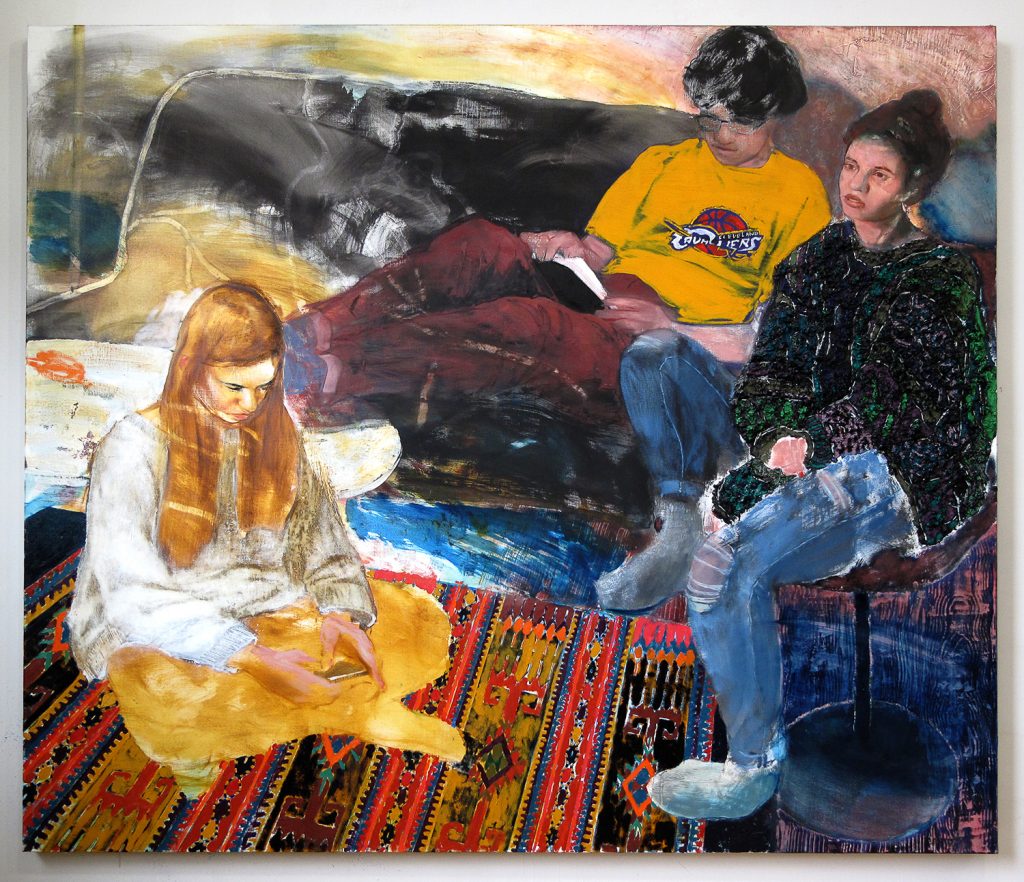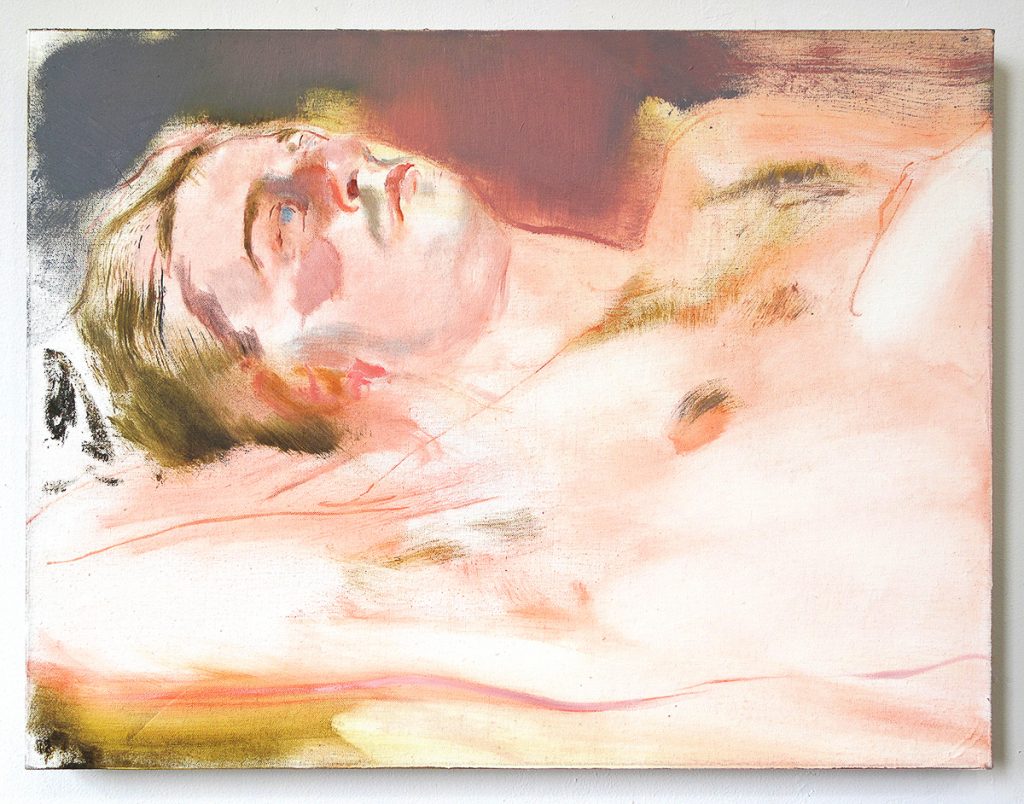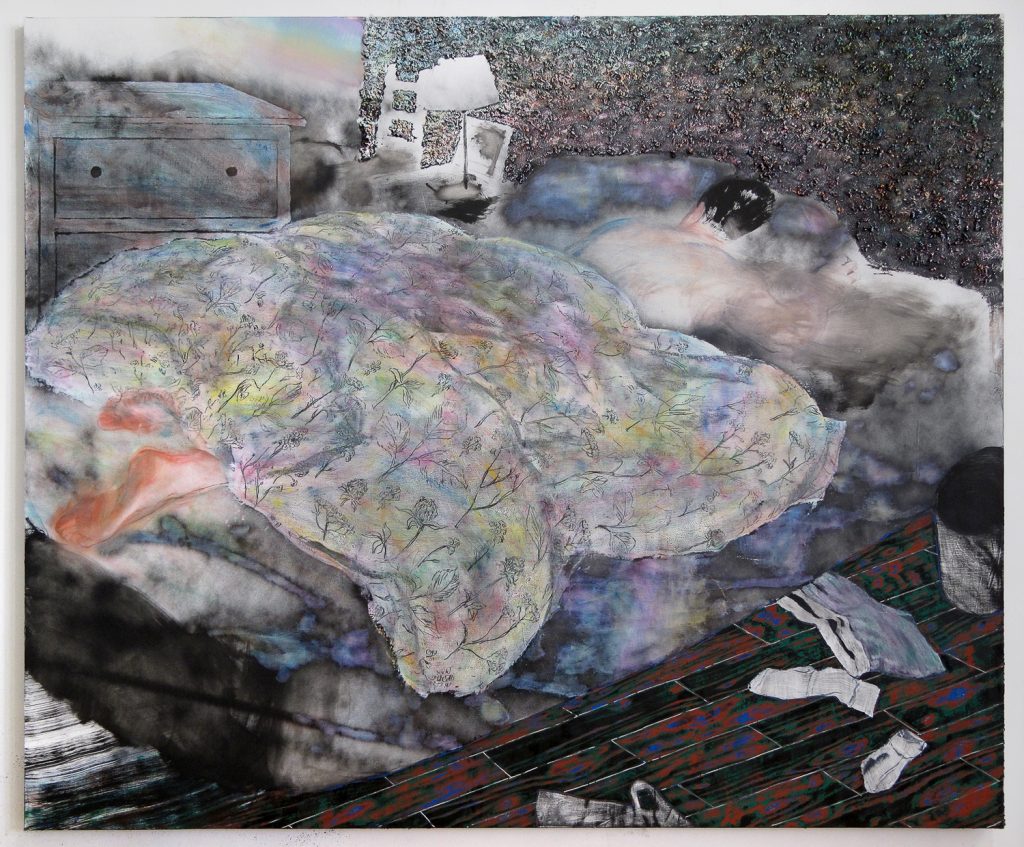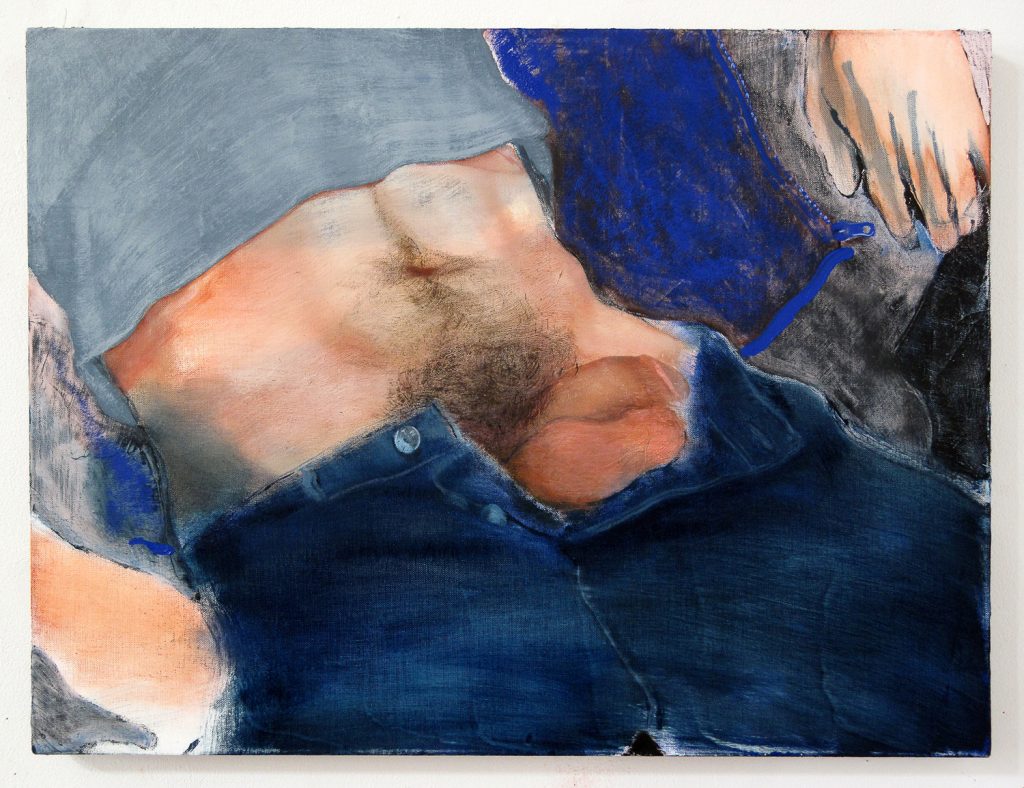New York-based painter Doron Langberg builds portraits of friends, family, and lovers using many layers of paint and detail. Working in a contrast between gestural figures and detailed environments, Langberg builds worlds in which the viewer can explore the emotionality of the human subject while still finding footing in concrete, inanimate surroundings. I speak with Langberg below about his process, inspirations, and what it means to be a queer artist. Don’t forget to check out his first solo show, Nothing Personal, on view now at 1969 Gallery in New York City.
Could you tell us a little bit about yourself and your work?
I grew up in Israel, and moved to the US to study painting at 21 after finishing my mandatory military service. I’ve been painting since I was very young and dreamt about being an artist in NYC since I was a little 12 yo gay boy. I did my undergrad at the Pennsylvania Academy of Fine Arts in Philly and then went on to do grad school at Yale. I work mostly from observation, and make large scale portraits of lovers, friends and family members. In my paintings I incorporate a lot of different textures and saturated colors to create a sense of atmosphere, closeness, and emotional intensity.
I find the development of your style very interesting. You work mostly in figuration, but some earlier works such as Morning Breath and Doorway are much more abstract than your current pieces. Can you speak to that trajectory of your work?
Definitely — those paintings were from a series of works I made in graduate school when I switched back to working in oil from acrylic, so I was trying out different ways of using oil paint to create light and texture. It’s funny for me to look back at these and realize how related they are to the work I’m making now! For example, the back wall in one of the paintings in my current show titled Morning 1, which depicts a sleeping figure, is identical to the texture in Morning Breath. In a way I feel that despite the shifts my work has taken over the years, I’ve actually been trying to achieve the same thing: to humanize queer intimacy and desire.
 Gil, Liran, Yonatan, 2018 / oil on linen / 60×70 inches
Gil, Liran, Yonatan, 2018 / oil on linen / 60×70 inches
There is a lot of detail and layering in your paintings, but often the most detail is seen in the objects and environments surrounding your subjects whereas the bodies and faces of the people are less clear and sometimes offer more of a suggestion of their detail and presence than a clear image. Why do you choose to create this contrast?
That’s for sure a recurring visual device I use. When I paint I think in layers, and in many of my paintings I reverse the figure-ground relationship where the figure will actually be the first layer, which is usually very loose and transparent, and the environment, objects, or clothing is painted on top, silhouetting the figure. That way, the figure is already integrated into its surroundings from the very start of the painting. The everyday objects in the paintings like socks, sweaters or rugs, are described much more concretely and add an element of reality to the paintings. Having a light touch with the figure allows the space and the formal elements to carry the psychological weight of the painting, representing the figure’s internal world.
 Cal, 2017 / oil on linen / 18×24 inches
Cal, 2017 / oil on linen / 18×24 inches
You’ve mentioned in the past that you try to use a very limited color palette. Why do you choose to limit your available colors? How does that contribute to the development of your paintings and point of view?
Color is such a huge mystery! When I was in undergrad — not knowing how to find my own voice within the overwhelming history of painting — I stopped painting all together and started making small graphite drawings of myself and guys I was with. By the end of my senior year these grew to be huge black and white acrylic painting on paper that were packed with texture and pattern. After finding a subject matter and a way of making, I felt confident enough to go back to painting in color. In graduate school I would sit around with a pile of color-aid papers trying to figure out how to create a color palette for a painting. Limiting the amount of pigments I used helped a lot in creating a coherent sense of light. In the last year actually that all changed and as I grew as a painter I feel I’m now able to juggle a lot more colors in a painting.
How do you see a painting through from start to finish? Where do the ideas and inspirations come from and do they change or transform throughout the process of creating the painting?
My ideas come from my everyday life and interacting with people around me. For example, I was in Berlin this summer for a residency and went to one of the lakes near by. People were lying around naked surrounded by wild flowers, it was so idyllic. I could envision myself painting that image, with the ground being really textured and rough, the flowers delicate and rendered, and the body half visible through the greenery. Once a subject matter and a way of painting come together in my mind I start the painting. After I follow my plan through and have the first few steps of the painting done, I try to spend some time with the painting and see where it needs to go. Since my initial impulse only takes me so far, it’s really through the process of painting that I fully understand the specificity of the experience I was trying to convey. Technically, I usually start with some color wash which I draw into, and because a lot of the under layers remain visible in the finished painting I would only apply opaque paint if I had a clear idea on how to paint a certain section. So despite my paintings seeming fast and gestural, they actually take me a long time to put together.
 Morning 1, 2018 / oil and spray paint on linen / 80×96 inches
Morning 1, 2018 / oil and spray paint on linen / 80×96 inches
Your paintings seem to create windows into worlds of intimacy and desire — familial, emotional, sexual. What interests you about these emotions and experiences?
Since as long as I can remember I’ve been obsessed with Van Gogh and David Hockney, who give you a glimpse into their lives and the lives of their sitters. Artists like Bonnard or Vuillard can paint the most mundane thing and imbue it with emotion. For me that’s what’s most powerful about painting — the ability to reach beyond oneself and make other people see the world through your eyes. Being queer, painting allows me to transform experiences that are demonized and marginalized into something others can relate to and identify with. By representing the people closest to me I want to show the many facets of queer life, and normalize it in a way, while not shying away from desires or attributes that are explicitly queer.
How do you feel about potential categorization as a gay or queer artist? Do you think that tendency at large is helpful or harmful to you as an artist and to viewers and consumers of your art?
I have so many feelings about this issue! It’s very important to me to identify as a queer artist and that the work reads as queer. In my mind there is no neutrality — if work is not queer in one way or another, it’s going to be read as straight, and I have no desire to pass as straight in any realm of my life. It infuriates me when people suggest that making queer work, or queer work that’s sexually explicit, is limiting or bad for one’s career. How is “queer” work more limiting than hard edge abstraction? How is it more of a “box”? We’ve been celebrating work that’s about straight sexuality, sometimes very explicit work, for centuries without framing it as somehow limiting. These concerns about categorization come from lack of exposure and homophobia, which my work is actively trying to push against.
 Avi, 2018 / oil on linen / 18×24 inches
Avi, 2018 / oil on linen / 18×24 inches
What are some sources of inspiration and influence for you?
I have to say my greatest source of inspiration is my friends. I feel super lucky to be part of an amazing painting community in NYC and I get motivated to adopt new ideas when I see my friends’ work. I made several pieces where I painted my friends in their studio, surrounded by their work, which gave me an excuse to paint their paintings. Trying to mimic their moves or use the same color palette as they do really expanded my own vocabulary and made me a better painter.
Where do you see yourself heading next? Any future plans you’d like to share with us?
My first solo show just opened at 1969 Gallery on the Lower East Side in New York City, which has been the culmination of months of work and planning, so I’m gathering my thoughts while making work for some future group shows. I’m doing the Sharpe-Walentas Studio Program right now, and because my new studio is double the size of my old one, I felt the need to try to make larger works so I stretched a few 96”x80” canvases. Since I’m a slow painter I was dreading the scale shift, but it turns out that it’s so much more fun, and even faster to work in that size! So that’s the most exciting new development in my work. You can come see for yourself at our open studios on April 27-29th!
For more information please visit doronlangberg.com.
